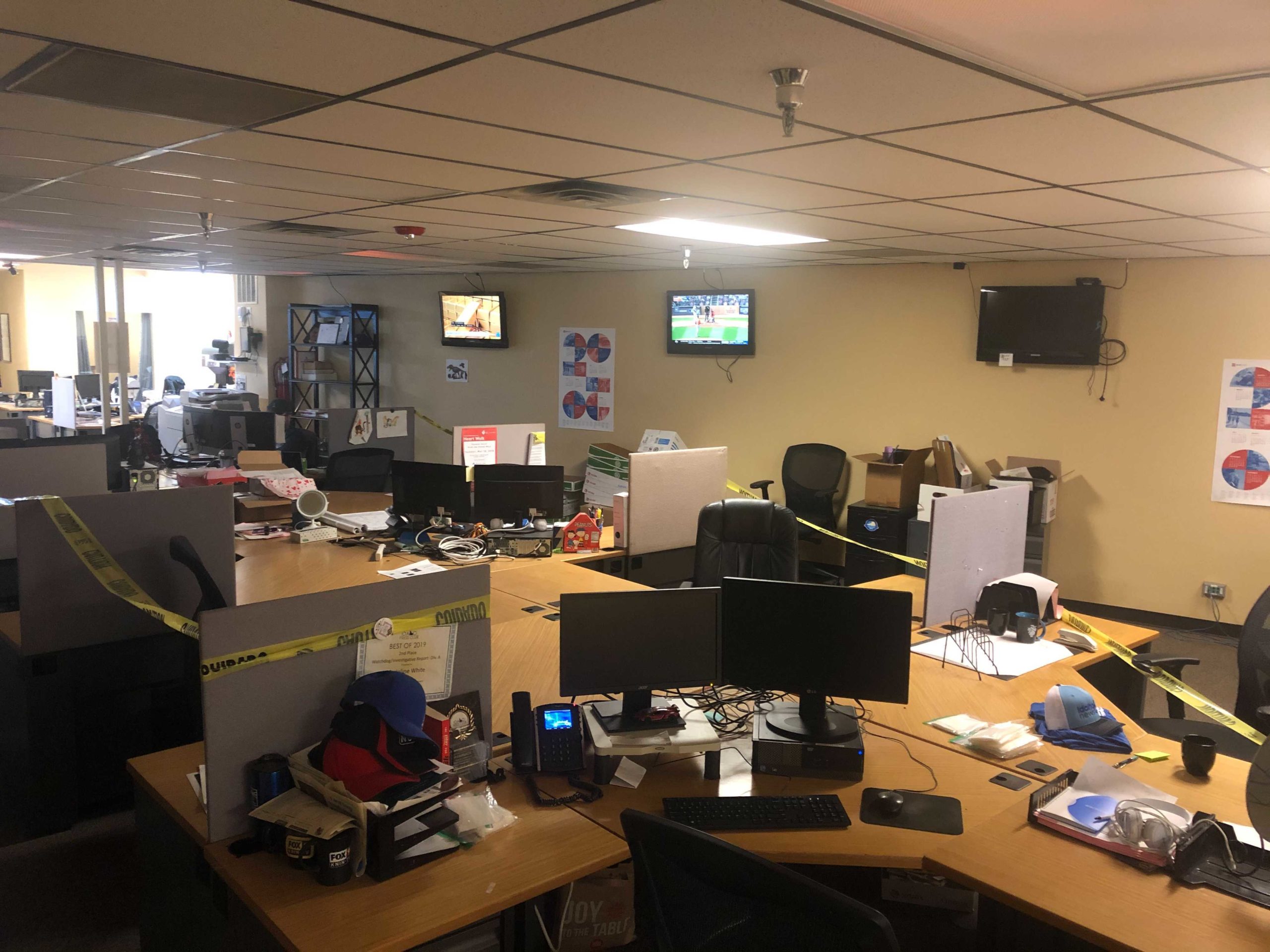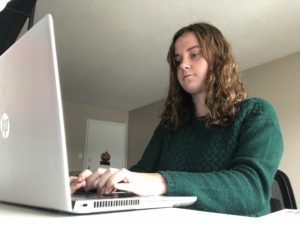This summer when Margo Snipe interned with the Tampa Bay Times, she lived with two other interns in St. Petersburg, Florida. Together they arranged a tiny office space at their kitchen table to work on stories.
“You could ask each other questions. If something was off, you could bounce it off of each other,” Snipe said. “You could complain about things you didn’t understand, or be happy with each other. It was a mini-newsroom.”
Two months later, Snipe was brought on full-time as a health equity reporter for the Times and moved. Since then, Snipe said she’s met only a handful of her colleagues while on assignment. As an intern, she was able to meet with her mentor a few times.
“It’s COVID, so I haven’t been out too much,” Snipe said. “When I was out, if I’d be on the same assignment as a photographer, I could introduce myself then.”
The coronavirus has changed a lot of things this year, including for reporters just starting out in what’s already a difficult field.
Several of them spoke to Poynter about what it’s like to work remotely in their first full-time jobs under the strain of the coronavirus pandemic, which has caused a separation from the newsroom. They’ve faced multiple challenges, including how to foster relationships with their colleagues from their homes and how to find footing with their beats and sources when social distancing is the new norm.
“It’s really difficult not being able to have a traditional newsroom setting like I was envisioning,” said Nicole Camarda, a reporter/multimedia journalist at KIVI-TV Idaho News 6. “It’s been a lot of reaching out to my fellow colleagues over email, over text, phone calls, which can be really hard.”
[the_ad id=”667826″]
A California transplant to Idaho, this is Camarda’s first job out of college. Though it’s been difficult, she said her colleagues have been welcome and understanding of the “fact that I started over Zoom, basically.”
Camarda stopped by the Idaho News 6 newsroom on her first day on the job back in June. She picked up a camera and other equipment and then went straight back home to log onto her first Zoom call. She’s been in the station periodically since. Camarda’s main beat is Canyon County, but because of the coronavirus, she has been doing a lot more general reporting.
“Trying to meet sources the typical way isn’t happening right now, so it’s a lot of reaching out over Facebook and trying to introduce myself over Facebook,” she said. “Everyone else is working online, so thankfully email and text messages have been successful.”

The empty Idaho News 6 newsroom. (Courtesy: J Bates)
There’s something truly magical about a newsroom, according to Tom Huang, assistant managing editor for journalism initiatives at The Dallas Morning News and a mentor to many interns and young journalists over the past three decades.
“There’s something really special about being in a place where there are that many interesting and strong personalities. Beyond the camaraderie, you’ll walk by someone’s desk or you’ll pass them by at the place for coffee and you’ll have a conversation, and ideas will start to spark,” Huang said. “This whole idea of coming up with ideas through serendipity, through just having the random collisions of people — that’s also part of the magic of the newsroom. And that’s really hard to replace on video chat.”
News organizations that are onboarding new reporters should not think of it as one event, according to Jill Geisler, a leadership expert and the Bill Plante Chair in Leadership & Media Integrity at Loyola University Chicago. It’s a process that usually starts with intense attention and information.
“In a normal time, we should be doing onboarding extremely well. We should have people get a real sense of the rules of the road and the culture, and maximize their opportunities to meet people they wouldn’t otherwise meet across departments. That’s in the best of times,” Geisler said. “I can’t walk you around the building today. I can’t take you over to circulation or I can’t take you over to marketing to meet (other employees), so those are going to be bigger mysteries than ever before because they’re operating in their own Zoom silos unless we are very intentional.”
[the_ad id=”667872″]
Geisler said the first three actions newsrooms should take to help young reporters adjust well in this pandemic are to:
- Introduce: Connect the new reporter with others, and touch base multiple times with the same colleagues if needed.
- Include: Make sure the reporter is included in meetings, even though it may not be closely related to their job. Geisler said this will help the reporter feel connected.
- Inform: Give the reporter information about their job and what others do, so they can feel empowered with knowledge.
Feedback is the biggest thing first-time reporters need to succeed before, during and after a story, Geisler said.
“They will not only help you as a reporter, but they’ll help you feel that people are invested in you.”
Everyone in a newsroom should feel like they have someone looking out for them, said Maria Carrillo, senior deputy editor, enterprise, at the Tampa Bay Times, which Poynter owns. The longtime journalist helped launch a mentorship program that pairs up Times journalists. Anyone at the newspaper who wants to mentor can participate, and mentors and mentees are encouraged to meet once or twice a month for six months either in person or virtually. Carrillo said the program was a goal of the newspaper’s diversity committee.
“Young people come into a newsroom and they’re learning their craft, learning the place and trying to understand everything,” Carrillo said. “It’s so helpful to have somebody point the way.”
Newsrooms can be lonely places, Carrillo said.
“Especially if you already feel a bit like an outsider, or an impostor. Having those connections is important.”
Mentorship is incredibly important in the newsroom, too, said Huang.
“A lot of the learning happens by doing and by coaching others. We really need to figure out how to bring that mentorship to the virtual world as well,” he said. “I have weekly short video chats with reporters across the newsroom just to check in with them, see how they’re doing, and then do whatever mentoring I can. But you have to be intentional like that. It’s not going to happen randomly.”
In her few months at the Tampa Bay Times, Snipe has reported stories that include COVID-19’s disproportionate impact on communities of color and a look at the high colorectal cancer rates among Black Americans in light of actor Chadwick Boseman’s death. Snipe, who came to Tampa Bay from Washington, D.C., is still new to the area.
[the_ad id=”667878″]
“Naturally if you go to a new job, co-workers would take you out. Maybe everyone would go to happy hour, maybe you’d get lunch. That doesn’t really happen in these times,” she said. “Moving to a new place would be difficult anyway, even in normal times, to make friends. So I think it’s exacerbated with COVID.”
Marissa Payne, who covers Cedar Rapids government for The Gazette in Cedar Rapids, Iowa, had some familiarity with her newspaper when she began working full time this year because of a 2018 internship she had there. But finding footing in her beat was still a challenge. Because everyone was working remotely, Payne said she didn’t always know what her colleagues were already reporting on. That was something she thought about because her government beat overlaps with other beats like public safety or business. It’s now smoother because she’s more settled at work.

Marissa Payne, who covers Cedar Rapids government for The Gazette in Cedar Rapids, Iowa, works from home. (Courtesy: Marissa Payne)
Reporting on the derecho storm that devastated swaths of Iowa and the Midwest helped Payne gain a stronger foothold on her beat. Many staff members lost power in their homes, she said, and so they worked out of the newspaper’s print press. That lasted for about two weeks.
“It’s super unfortunate that that’s how it had to happen, but there were so many sources that I had talked to over the phone a couple of times or had a Zoom introduction meeting with but hadn’t met in person, who I finally met at these city press conferences,” Payne said. “The storm helped (with) just getting to meet everyone.”
Payne misses newsroom banter and offhand comments that make her laugh. But there’s a bright side. The reporter said she can work in her pajamas on days when she doesn’t have to go out on assignment, and can make breakfast and lunch at home. And all her belongings are within reach.
“It’s important to be patient with yourself and kind to yourself as you’re starting out a new job remotely,” Payne said. “The times are very strange, so it’s just important to give yourself that time to learn and grow because working remotely adds a whole layer of complication to that.”
Amaris Castillo is a writing/research assistant for the NPR Public Editor and a contributor to Poynter.org. She’s also the creator of Bodega Stories and a very tired mom. Amaris can be reached at acastillo@poynter.org or on Twitter @AmarisCastillo.






